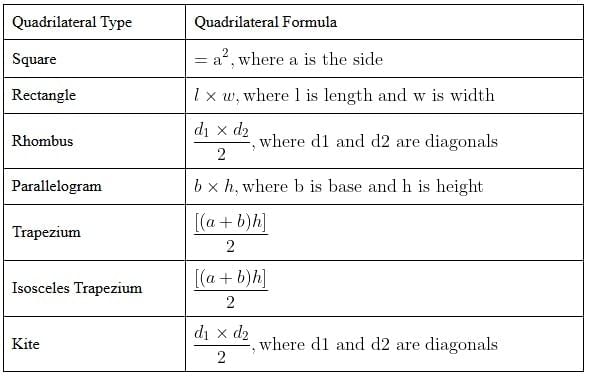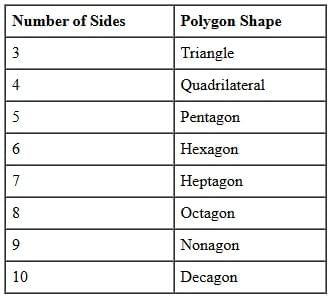Important Formulas: Quadrilateral and Polygons | Quantitative Aptitude for SSC CGL PDF Download
Quadrilateral Types

Example of Quadrilateral:
Q: If the area of a rectangle is 48 and the length is 8, what is the width?
Sol: Given, area=48, and l=8
To find: width w
Formula: l×w
Area of rectangle=l×w
48 = 8(w)
w=48 / 8 = 6
Polygon
In the realm of Mathematics, a polygon is identified as a two-dimensional closed figure, composed of straight line segments. It's worth noting that a polygon is not a three-dimensional shape and does not contain any curved surfaces. A polygon must have at least three sides, and each line segment should intersect with another line segment only at its endpoint. The shape of a polygon can be easily recognized from the number of sides it possesses. Below is a list of various polygon shapes along with their corresponding number of sides.
Classification of Polygons:
Polygons can be classified based on their angle measurements and the length of their sides. Here are the main types:
- Regular Polygon – All sides and interior angles are of equal measurement
- Irregular Polygon – The sides and interior angles vary in measurement
- Convex polygon – All the interior angles of a polygon are strictly less than 180 degrees
- Concave Polygon – At least one interior angle of a polygon exceeds 180 degrees
Formulas Related to Polygons:
Here are some important formulas related to polygons:
- The sum of interior angles of a polygon with “n” sides =180°(n-2)
- Number of diagonals in an “n-sided” polygon = [n(n-3)]/2
- The measure of interior angles in a regular n-sided polygon = [(n-2)180°]/n
- The measure of exterior angles in a regular n-sided polygon = 360°/n
Key Properties of Polygons:
Here are some important properties of polygons:
- The sum of all interior angles in a quadrangle equals 360 degrees.
- A polygon is termed as concave if at least one of its interior angles is greater than 180 degrees.
- A polygon is termed as a simple polygon if it does not cross over itself and has only one boundary. If not, it is a complex polygon.
Example of a Polygon
Q: Calculate the sum of the interior angles of a pentagon.
Sol:
We know that a pentagon has five sides.
The formula to calculate the sum of interior angles is:
Sum of interior angles = 180°(n-2)
= 180°(5-2)
= 180° (3)
= 540°
Therefore, the sum of the interior angles of a pentagon equals 540°.
|
317 videos|290 docs|185 tests
|
FAQs on Important Formulas: Quadrilateral and Polygons - Quantitative Aptitude for SSC CGL
| 1. What are the different types of quadrilaterals based on their properties? |  |
| 2. What are the important formulas related to quadrilaterals? |  |
| 3. How can one determine if a quadrilateral is a parallelogram? |  |
| 4. What is the significance of the sum of the interior angles in a quadrilateral? |  |
| 5. How can the area of a quadrilateral be calculated if the lengths of all sides are known? |  |















